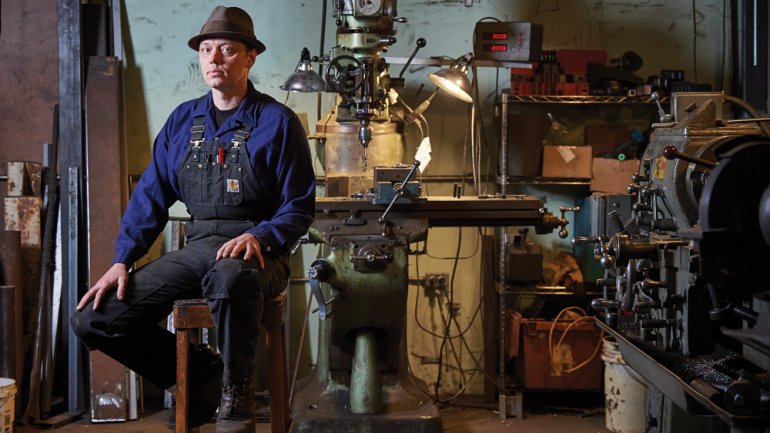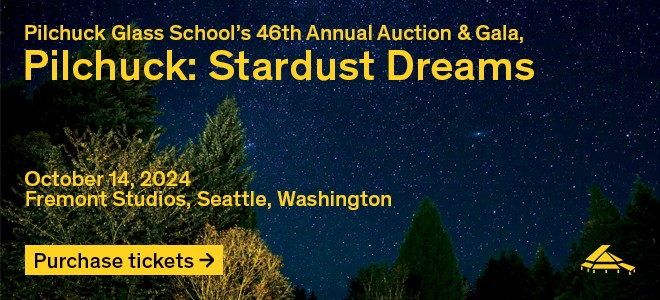Man Out of Time
Man Out of Time
Kris Perry’s studio occupies a corner of a massive one-story building that once housed the second-largest furniture factory in the country. It sits across the railroad tracks from an abandoned factory on the waterfront of Hudson, New York, a couple hours north of Manhattan. It’s fitting that Perry has landed in this post-industrial city; he turns the remnants of American manufacturing into bold new forms. In work boots, a beat-up fedora, and a threadbare suit over a T-shirt, Perry looks like a tour guide at an amusement park called The Industrial Age.
The child of a carpenter and a textile artist, Perry, 34, grew up in a community in the Bay Area where people made things with their hands, leaving a lasting impression of the value of craft. A vocation that began with Legos at age 2 blossomed in adolescence when he worked on a broken-down BMX bike he had bought secondhand. “We didn’t have any money, so I couldn’t take it in for repair,” Perry remembers. “The mechanic at the local bike store took pity on me and spent a couple hours teaching me how to do all the maintenance . . . That was my introduction to working on mechanical things.”
A Jeep in need of a new bumper led Perry to study welding and metallurgy at community college. After two semesters of classes and some on-the-job training at local shops, he opened a shop of his own, where he worked for sculptors in the Bay Area and, in the process, refined his foundry and fabrication skills. He then studied sculpture at California College of the Arts in Oakland. Now he uses his skills in his studio on a daily basis, bending, cutting, welding, and grinding crude forms into refined shapes.
A short walk from Perry’s studio is Basilica Hudson, where 2017’s Revolution is installed on the grounds of the avant-garde cultural center, a former foundry and glue factory. It’s a deceptively simple construction: a propeller with a vane-like tail mounted on a tripod. But the piece both embodies Perry’s influences and functions as a survey of 20th-century American sculpture: David Smith in the precision welding, Alexander Calder and Mark di Suvero in the kinetics (the propeller and vane swivel in the wind), Louise Bourgeois in the spidery legs, Isamu Noguchi in the interaction with the landscape.
Like these artists, Perry also works big, combining the abstract with the crowd-friendly. “I’m passionate about working on a large scale,” he says. “You have a different experience when you’re dealing with a large-scale piece of art, and I love creating an architectural space. You’re not just standing back and looking — you can walk under it. You can have a picnic under it. Art shouldn’t be exclusive. Anybody can come and see it at any time.”
This vein of egalitarianism is what the artist’s mentor, fellow sculptor David Best, finds most remarkable in Perry’s work. “Most contemporary art is intellectual to the point of exclusion,” Best says. “Kris is not a modern artist in that way. His work doesn’t exclude people; almost anyone can access it.” Best also admires Perry’s mastery of the fundamentals of his craft: “If you look at David Smith, he was a fabricator. He made a living charging to do welding. Kris handles himself as professionally. I have total confidence in him and his commitment to the craft.”
The work that brought Perry wide attention was his collaboration with Hudson’s musical community, including Replacements co-founder Tommy Stinson, in 2012. Their Machines project consists of 15 pneumatically and electromechanically powered sound producing sculptures that Perry created from industrial refuse for the musicians to play, most notably at the 2013 O+ Festival in Kingston, New York. These fully operational instruments employ booming percussion, low-frequency vibration, and vacuum-blown pipes to create a cacophony that sits somewhere between performance art and sculpture. “I was taking used industrial equipment out of the auto plants to create a dialogue about the Rust Belt industry and American craftsmanship,” Perry says. “The project has an aesthetic that speaks to the inventions of the Industrial Revolution, but the machines themselves are made possible by the decline of industrialism [in] this country.”
When Perry is not salvaging fan-blade assemblies from industrial cooling towers – that’s where he found the propeller for Revolution – he’s in his studio, dreaming up new forms, welding aerodynamic sculptures that reference hot rods and airplanes and robot critters from the Terminator franchise. “I love shapes that you want to run your hand over, streamlined shapes that you can imagine air flowing over,” says Perry, who recently traded a sculpture for a sleek Moto Guzzi motorcycle.
Standing outside his studio, Kris Perry looks like an artist with one foot in the past and one in the future, reconciling and balancing those polarities in the present. “There’s a part of my soul that likes to be a Luddite, but it’s important to reflect the times,” says Perry, who’s begun 3D-printing maquettes of his work. “Artists capture the spirit of the times. It’s a historical record that’s more on the emotional and spiritual level than a straight documentation.” A few hundred feet away, against the backdrop of America’s industrial past revived from decay, Revolution’s shiny propeller spins in the breeze.




